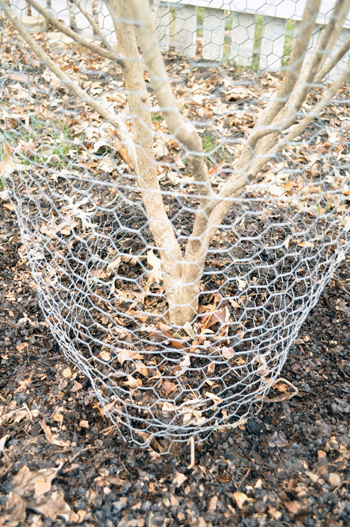Rabbit Damage Prevention in the Landscape
Return to Miscellaneous Agent Articles
- Once rabbits have damaged young trees there is no recourse
- Prevention is the key to controlling rabbit issues.
- Fencing is the most effective method for preventing damage
 A walk through many yards during the spring reveals that rabbits had a feeding frenzy during the cold months or while the ground was snow covered. Their favorite course in gardens includes roses, shrubs and young tree bark. Rabbit feeding is easy to spot, as they leave a clean-looking cut, usually at a downward angle, or areas where the bark has been gnawed. In some cases, it was very easy to tell rabbits were the cause, as the ground can be littered with droppings.
A walk through many yards during the spring reveals that rabbits had a feeding frenzy during the cold months or while the ground was snow covered. Their favorite course in gardens includes roses, shrubs and young tree bark. Rabbit feeding is easy to spot, as they leave a clean-looking cut, usually at a downward angle, or areas where the bark has been gnawed. In some cases, it was very easy to tell rabbits were the cause, as the ground can be littered with droppings.
Tree damage the most serious
Trunk damage is the most severe form of rabbit damage. Shoots of shrubs can be pruned and the plant will recover. But once damage has been done to the main trunk of a tree, the vascular system is compromised and the plant is less likely to ever regain its full strength.
Methods for preventing rabbit damage to plants
Prevention is always the key to controlling rabbit issues. The problem is that many of us do not like the control methods, as they are not always easy or surefire.
Exclusion — just a fancy way of saying fencing
The most reliable and recommended way is exclusion. Exclusion is a fancy way of saying "fence them out." Fencing is best accomplished with chicken wire at least 18 to 24 inches high. The wire cage then surrounds the plants. One problem with this method is snow drifts. In some locations where the snow cover is deep the rabbits can feed at a higher level. In this case, the woven wire may not be high enough to prevent the damage. Tree wraps will help to protect young tree trunks. Wrap young trees from the ground to the point where the first branches appear.
Chemical repellents
Repellents are available but normally do not give satisfactory results. Rain and snow decrease their effectiveness. There are two types of repellents, those that work by smell and the other by taste. Use at your own risk.
Trapping
Trapping is another method of helping to reduce the rabbit problem. Live trapping can be accomplished, but then you must deal with the animal. Also keep in mind that rabbits spend their lives in very small areas. Once the population is reduced in one area, they just move in from another area.
As you can see, there is no easy answer to rabbit issues. The best solution is to be prepared and prevent the damage.

Have questions? The Garden Hotline is staffed by trained EMG volunteers and Extension staff who will assist you with questions.
Phone: (913) 715-7050
Email: garden.help@jocogov.org